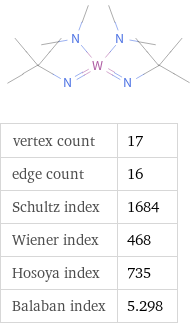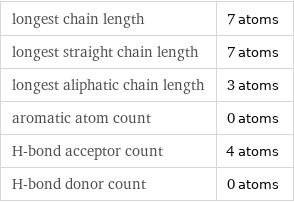Input interpretation

bis(tert-butylimino)bis(dimethylamino)tungsten(vi)
Basic properties
(C)C)(N(C)C)N(C)C InChI identifier | InChI=1/2C4H9N.2C2H6N.W/c2*1-4(2, 3)5;2*1-3-2;/h2*1-3H3;2*1-2H3;/q;;2*-1;+2 InChI key | JVCWKXBYGCJHDF-UHFFFAOYSA-N](../image_source/56ebf627d0f179881d133228a0afd6ce.png)
molar mass | 414.2 g/mol formula | C_12H_30N_4W empirical formula | C_12N_4W_H_30 SMILES identifier | CC(C)(C)N=[W](=NC(C)(C)C)(N(C)C)N(C)C InChI identifier | InChI=1/2C4H9N.2C2H6N.W/c2*1-4(2, 3)5;2*1-3-2;/h2*1-3H3;2*1-2H3;/q;;2*-1;+2 InChI key | JVCWKXBYGCJHDF-UHFFFAOYSA-N
Structure diagram

vertex count | 17 edge count | 16 Schultz index | 1684 Wiener index | 468 Hosoya index | 735 Balaban index | 5.298
Quantitative molecular descriptors

longest chain length | 7 atoms longest straight chain length | 7 atoms longest aliphatic chain length | 3 atoms aromatic atom count | 0 atoms H-bond acceptor count | 4 atoms H-bond donor count | 0 atoms
Elemental composition

Find the elemental composition for bis(tert-butylimino)bis(dimethylamino)tungsten(vi) in terms of the atom and mass percents: atom percent = N_i/N_atoms × 100% mass percent = (N_im_i)/m × 100% Plan: • Write the chemical formula and gather atomic masses from the periodic table. • Determine values for N_i, m_i, N_atoms and m using these items. • Finally, compute the percents and check the results. Write the chemical formula: C_12H_30N_4W Use the chemical formula to count the number of atoms, N_i, for each element and find the total number of atoms, N_atoms, per molecule: | number of atoms C (carbon) | 12 N (nitrogen) | 4 W (tungsten) | 1 H (hydrogen) | 30 N_atoms = 12 + 4 + 1 + 30 = 47 Divide each N_i by N_atoms to calculate atom fractions. Then use the property that atom fractions must sum to one to check the work: | number of atoms | atom fraction C (carbon) | 12 | 12/47 N (nitrogen) | 4 | 4/47 W (tungsten) | 1 | 1/47 H (hydrogen) | 30 | 30/47 Check: 12/47 + 4/47 + 1/47 + 30/47 = 1 Compute atom percents using the atom fractions: | number of atoms | atom percent C (carbon) | 12 | 12/47 × 100% = 25.5% N (nitrogen) | 4 | 4/47 × 100% = 8.51% W (tungsten) | 1 | 1/47 × 100% = 2.13% H (hydrogen) | 30 | 30/47 × 100% = 63.8% Look up the atomic mass, m_i, in unified atomic mass units, u, for each element in the periodic table: | number of atoms | atom percent | atomic mass/u C (carbon) | 12 | 25.5% | 12.011 N (nitrogen) | 4 | 8.51% | 14.007 W (tungsten) | 1 | 2.13% | 183.84 H (hydrogen) | 30 | 63.8% | 1.008 Multiply N_i by m_i to compute the mass for each element. Then sum those values to compute the molecular mass, m: | number of atoms | atom percent | atomic mass/u | mass/u C (carbon) | 12 | 25.5% | 12.011 | 12 × 12.011 = 144.132 N (nitrogen) | 4 | 8.51% | 14.007 | 4 × 14.007 = 56.028 W (tungsten) | 1 | 2.13% | 183.84 | 1 × 183.84 = 183.84 H (hydrogen) | 30 | 63.8% | 1.008 | 30 × 1.008 = 30.240 m = 144.132 u + 56.028 u + 183.84 u + 30.240 u = 414.240 u Divide the mass for each element by m to calculate mass fractions. Then use the property that mass fractions must sum to one to check the work: | number of atoms | atom percent | mass fraction C (carbon) | 12 | 25.5% | 144.132/414.240 N (nitrogen) | 4 | 8.51% | 56.028/414.240 W (tungsten) | 1 | 2.13% | 183.84/414.240 H (hydrogen) | 30 | 63.8% | 30.240/414.240 Check: 144.132/414.240 + 56.028/414.240 + 183.84/414.240 + 30.240/414.240 = 1 Compute mass percents using the mass fractions: Answer: | | | number of atoms | atom percent | mass percent C (carbon) | 12 | 25.5% | 144.132/414.240 × 100% = 34.79% N (nitrogen) | 4 | 8.51% | 56.028/414.240 × 100% = 13.53% W (tungsten) | 1 | 2.13% | 183.84/414.240 × 100% = 44.38% H (hydrogen) | 30 | 63.8% | 30.240/414.240 × 100% = 7.300%
Elemental oxidation states

The first step in finding the oxidation states (or oxidation numbers) in bis(tert-butylimino)bis(dimethylamino)tungsten(vi) is to draw the structure diagram. Next set every oxidation number equal to the atom's formal charge: In bis(tert-butylimino)bis(dimethylamino)tungsten(vi) hydrogen is not bonded to a metal with lower electronegativity, so it will have an oxidation state of +1. Any element bonded to hydrogen gains the bonding electrons, decreasing their oxidation state by 1 for every bond: With hydrogen out of the way, look at the remaining bonds. There are 6 carbon-nitrogen bonds, 4 nitrogen-tungsten bonds, and 6 carbon-carbon bonds. For each of these bonds, assign the bonding electrons to the most electronegative element. First examine the carbon-nitrogen bonds: element | electronegativity (Pauling scale) | C | 2.55 | N | 3.04 | | | Since nitrogen is more electronegative than carbon, the electrons in these bonds will go to nitrogen. Decrease the oxidation number for nitrogen in every highlighted bond (by 1 for single bonds, 2 for double bonds, and 3 for triple bonds), and increase the oxidation number for carbon accordingly: Next look at the nitrogen-tungsten bonds: element | electronegativity (Pauling scale) | N | 3.04 | W | 2.36 | | | Since nitrogen is more electronegative than tungsten, the electrons in these bonds will go to nitrogen: Next look at the carbon-carbon bonds: element | electronegativity (Pauling scale) | C | 2.55 | C | 2.55 | | | Since these elements are the same the bonding electrons are shared equally, and there is no change to the oxidation states: Now summarize the results: Answer: | | oxidation state | element | count -3 | C (carbon) | 6 | N (nitrogen) | 4 -2 | C (carbon) | 4 +1 | C (carbon) | 2 | H (hydrogen) | 30 +6 | W (tungsten) | 1
Topological indices

vertex count | 47 edge count | 46 Schultz index | 20470 Wiener index | 5592 Hosoya index | 6.434×10^7 Balaban index | 9.884